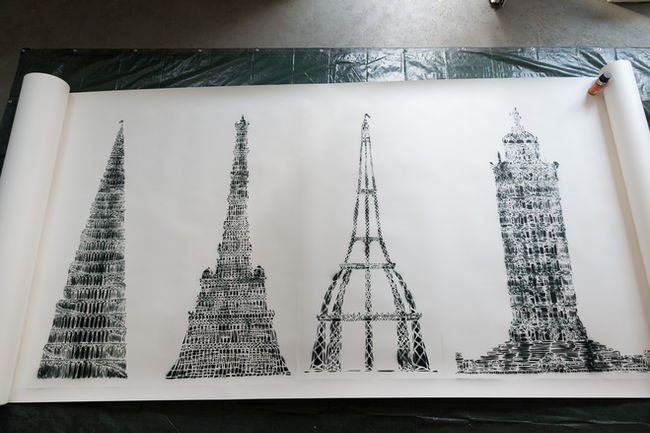LIVIL
Survival of the fittest 2012/ Nachtbusch 2014
During my second trip to the Nachtbusch Festival in 2014, I embarked on a project to recreate half of the 68 proposed designs for London's own Eiffel Tower. London's bold proclamation, "Anything Paris can do, London can do bigger!" served as the driving force behind this endeavor. Immersed in historical narratives, I delved into the complexities of ambition, rivalry, and consequence. Transforming selected designs into stencils, I meticulously painted them onto a 20 by 1.2-meter-long carton-paper canvas at the festival in Mannheim. This process allowed me to forge a deep connection with the visionary architects of the past. Furthermore, uncovering the fate of the Watkin Tower's first floor, repurposed for steel production during WW1, highlighted the intertwined nature of ambition and historical context. During my first exhibition, "Survival of the Fittest," in December 2012, I had the opportunity to paint directly on the walls. I depicted group portraits, including a labor union, a gathering of businessmen, and family portraits. Accompanying these were my "modern hieroglyphs," created from fragmented forms, each containing information from word lists I maintain. It was during this exhibition that I also met Anne Vieth, who later wrote about the exhibition. Characteristic of LIVIL's work is the fusion of images and text, which he exploits for their inherent associative richness. Typically portraying group dynamics within families, companies, or other social entities, his images are paired with "modern hieroglyphs," fragmented forms extracted and enlarged from the stencils used. These three components create wall works that suggest a scientific systemization, influenced by Hölzl's background in international economic relations, which instilled in him an analytical, systematizing mindset. However, the emotional resonance evoked by the chosen terms and imagery subverts this initially objective principle, creating tension between system and emotion that enhances the strength of LIVIL's works. For instance, the concept of family is expressed in family portraits and crests. LIVIL abstracts historical family photos and documents, imbuing them with a degree of universality through deindividualization. Stereotypical images of familial bliss embody the expectations and norms of this social unit. The ambivalence inherent in the family system is underscored by terms such as "black sheep," "maternal love," and "trophy wife," which evoke both positive and negative connotations and elicit strong emotions tied to personal experiences within the family sphere. LIVIL's works visualize the inherent ambivalence within all social groups, reflecting both the desire to belong and the realization that group membership profoundly influences individual behavior. Communities are identity-shaping and require conscious acknowledgment of their mechanisms. This awareness is evident in works critiquing the realms of pornographically motivated, economically driven, and militarily acting collectives. Text by Anne Vieth





















